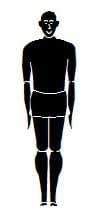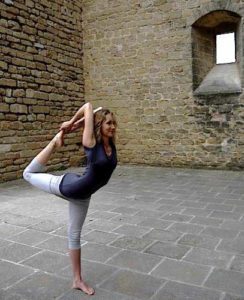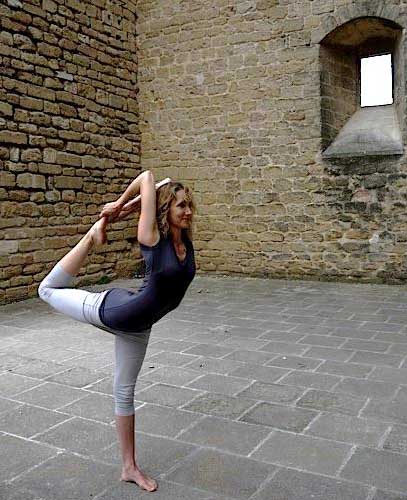Patanjali’s linked concepts of “sthira” and “sukha”–effort and ease–can help structure your teaching. Learn how situating your instruction between these two poles can help your students find harmony.
In describing the qualities of asana with the adjectives “sthira” and “sukha,” Patanjali uses language very skillfully. Sthira means steady and alert–to embody sthira, the pose must be strong and active. Sukha means comfortable and light–to express sukha, the pose must be joyful and soft. These complimentary poles–or Yin and Yang co-essentials–teach us the wisdom of balance. By finding balance, we find inner harmony, both in our practice and in our lives.
As teachers, we need to help our students find that balance in their practice. Our instruction should assist them in an exploration of both sthira and sukha. In practical terms, we should begin by teaching sthira as a form of connection to the ground, and then move to sukha as a form of lighthearted exploration and expansion. In this way, we can teach from the ground up.
Manifesting steadiness (sthira) requires connecting to the ground beneath us, which is our earth, our support. Whether our base is comprised of ten toes, one foot, or one or both hands, we must cultivate energy through that base. Staying attentive to our roots requires a special form of alertness. Our instruction should begin there by helping students cultivate this alertness at the base of a pose. I will demonstrate this form of instruction for Tadasana, the blue print for all the other standing poses. The principles of Tadasana can be easily adapted to any standing pose you wish to teach.

In all the standing poses, steadiness comes from rooting all sides of the feet like the stakes of a tent. We need to teach students with high arches to pay particular attention to grounding their inner feet, and show students with fallen arches to move their ankles away from each other.
After rooting the feet, we move up, reminding students to draw the kneecaps up, the upper inner thighs in and back, and the outer sides of the knees back. This allows students to notice whether their weight feels evenly distributed between the right and left leg, the front and back of the foot, and the inner and outer thighs.
Next we should remind our students to adjust the pelvis, allowing the weight of the hips to be above the knees and ankles. This often requires them to draw their weight slightly back in order to allow the point of the coccyx to face down. In this alignment, the tailbone is not tucked nor lifted, but merely directed down between the fronts of the heels. Those with flat lumbar spines will need to allow the tailbone to move slightly back, moving away from tucking, while those with over-arched backs will need to encourage the tailbone to draw slightly in.
We should then instruct our students to lengthen the side waist, lift the top of the sternum and relax the shoulders down the back, aligning them over the hips and ankles. They should bring their heads above their shoulders, aligning the chin in the same plane as the forehead. Finally, they should relax the jaw, allowing the tongue to float freely in the mouth and the eyes to soften.
Once our students have attended to steadiness, the other qualities of alertness and comfort become accessible. They are now ready to bring their hands into Namaste position and reflect on their motivation before beginning their practice.
 Encourage your students to view this grounded base as their home base, the foundation from which they can create, explore, and at times expand. From there, they can navigate to a place of ease or sukha. Just as steadiness requires and develops alertness, comfort entails remaining light, unburdened, and interested in discovery. By teaching this quality, we encourage a balanced equilibrium rather than impose rigid rules for alignment. This helps students develop a natural respect toward their bodies and themselves, while encouraging them to fully inhabit their bodies. They can then learn to move away from commanding their bodies to perform poses, and instead breathe life into them from the inside.
Encourage your students to view this grounded base as their home base, the foundation from which they can create, explore, and at times expand. From there, they can navigate to a place of ease or sukha. Just as steadiness requires and develops alertness, comfort entails remaining light, unburdened, and interested in discovery. By teaching this quality, we encourage a balanced equilibrium rather than impose rigid rules for alignment. This helps students develop a natural respect toward their bodies and themselves, while encouraging them to fully inhabit their bodies. They can then learn to move away from commanding their bodies to perform poses, and instead breathe life into them from the inside.
With sthira and sukha as the points on our compass, we can organize our teaching and help our students enjoy exploring their places of limitation and liberation in every pose. As a result, regardless of your students’ individual abilities, their practice can focus on celebration and refreshment.
At a deeper level, the way we practice and teach yoga poses mirrors the way we live the rest of our lives. As we reflect on our practice and our teaching, we can use yoga as a tool for developing greater insight into ourselves and the world around us. Sthira and sukha can then become not only tools for teaching or understanding yoga, but also principals that help guide the way we live.
Sarah Powers will be leading the SOYA Annual Retreat with her husband Ty Powers this coming June 6-8, 2014 in Naramata BC.
Reprinted with permission from Sarah Powers. Published in Yoga Journal, September 2005, Photos added by Mugs McConnell
Celebrating 30 Years of yoga teacher training excellence in 2025


Recent Comments